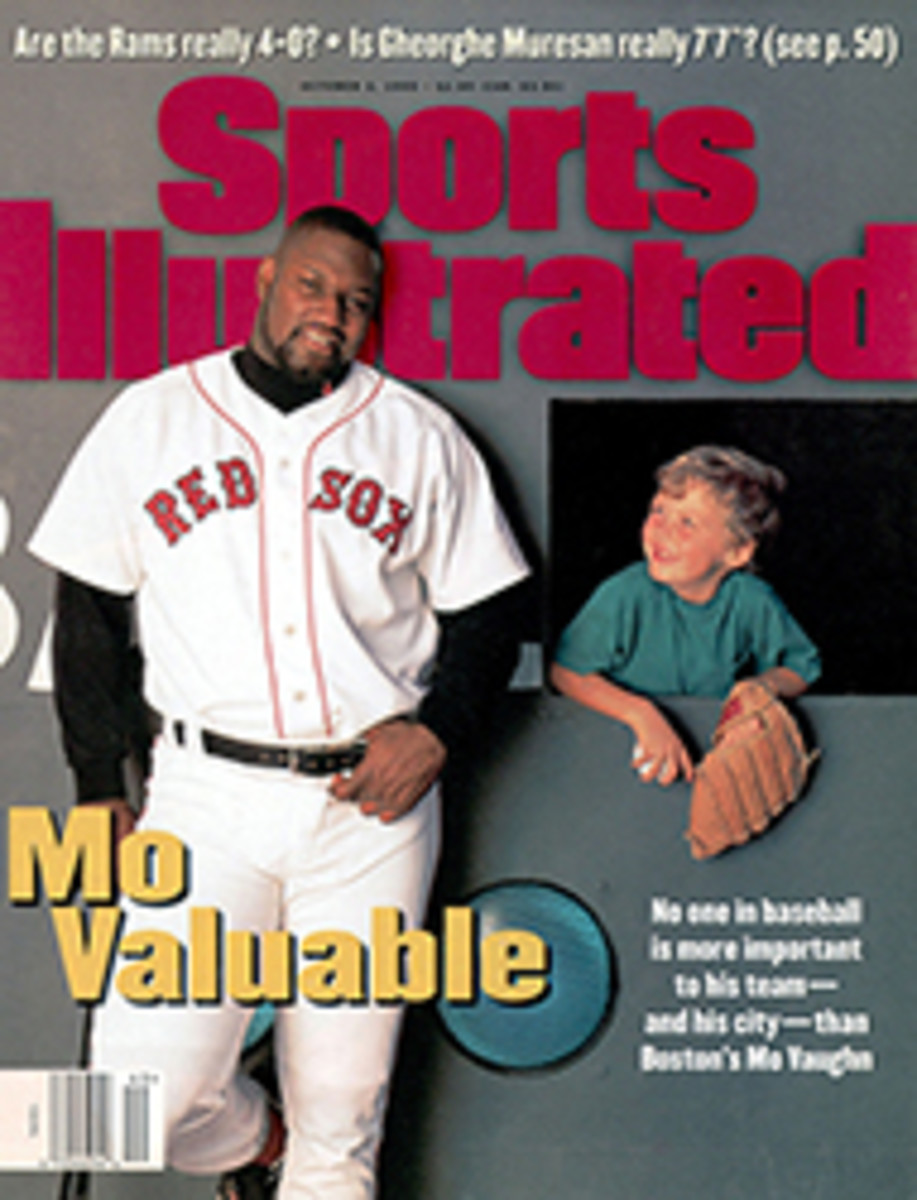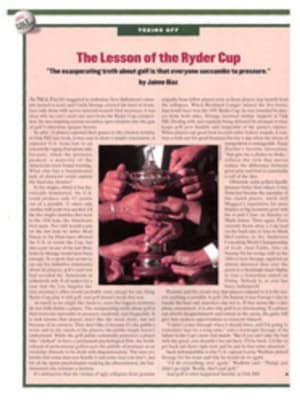
PLAYING WITH TRADITION THE WORLD ESKIMO-INDIAN OLYMPICS CELEBRATE AGE-OLD NATIVE AMERICAN SPORTS
Robert Okpeaha Jr. is the Cyrano de Bergerac of ears. His ears are the size of saucers and feature folds of cartilage as thick as drinking straws. They're separated from his head by at least an inch of ear canal. They are protrusions befitting the 10-time ear-pull champion of the world.
Ear-pulling, for those unfamiliar with the activity, is a tug-of-war involving the ears. Two competitors sit facing each other, legs locked, heads about two feet apart. A loop of string is placed around the right ear of one contestant and the left ear of the other. They pull their heads straight back until one person succumbs to the pain, twisting his or her head to release the string. This takes from 10 seconds to several minutes. Best of three wins the match, with ears alternated from pull to pull.
The ear-pull is one of the glamour events at the World
Eskimo-Indian Olympics, the 35th edition of which took place in July at the Big Dipper Ice Arena in Fairbanks, Alaska. The Eskimo-Indian Olympics are the largest yearly gathering of Native Alaskans and Canadians, with more than 500 athletes and dancers competing in 24 events over four days. While most of the sports are unknown outside native cultures, for peoples of the extreme north they are far more important than any game that will be played in Atlanta next summer. As Okpeaha prepared for the ear-pull finals, the last event of the second day, 4,000 spectators urged him and his opponent on, shouting in English, Yupik, Tlingit and half a dozen other tongues.
Like most of the events at the Eskimo-Indian Olympics, the ear-pull is based on ancient survival and hunting skills. It was developed to toughen hunters' ears so they could endure extended periods in the Arctic cold. Ears are highly susceptible to frostbite. The hardier one's ears, the reasoning went, the longer one would be able to hunt--and, by extension, the better the tribe would eat. Hence the ear-pull.
Apart from his magnificent ears, Okpeaha is a small man, about 5'5", with a shock of black hair and a sharply downturned nose. He is an Inupiaq Eskimo from Barrow, the northernmost community in the U.S., a place where the sun does not rise all winter and temperatures of 60 degrees below zero are common. There is an air of mystery about him. He appears to be in his late 40's but divulges few personal details."I'm probably the oldest competitor here" is about all he'll let on, "and I'm not going to retire until somebody beats me.'
No need to worry about that. Okpeaha's opponent in the finals, 23-year-old Richard Egnaty of Sleetmute, Alaska, hardly stood a chance. Okpeaha removed his plastic-framed eyeglasses, slipped the twine behind his right ear and narrowed his eyes. Then he calmly began to pull. Within seconds, Egnaty's ear was so scrunched it looked like a morel mushroom. It went from pink to crimson to a dark purple. Okpeaha's ear seemed hardly disturbed. Egnaty's facial muscles strained. Okpeaha didn't even wince.
"These are the longest seconds of Richard's life," said Asta
Keller, winner of an eighth straight women's ear-pull title earlier in the day. "For two weeks it will feel like there's fire in his ears." The 33-year-old Keller--whose ears appear entirely ordinary--comes from a long line of ear-pullers. "My grandfather was an ear-pull wizard," she said. But she warns against pulling too hard. Her brother once received a gash behind his ear that required seven stitches.
At least once in competition, an ear has been pulled off completely. But in this year's men's final no serious damage occurred. Okpeaha won in two quick pulls to earn his 10th title. Egnaty stumbled out of the arena moaning, hands cupped over his ears.
The Eskimo-Indian Olympics began in 1961 as a way to preserve native games in regions where traditional lifestyles were being encroached on by modern society. The games are open to anyone of at least 25% blood connection to one of the eight Native Alaskan or Native Canadian groups: the Aleut, Inupiat and Yupik Eskimos; and the Tsimshian, Haida, Athabascan, Eyak and Tlingit Indians.
Two types of games are played at the Eskimo-Indian Olympics:
those that require balance and dexterity, and those that inflict pain and suffering. (Ear-pulling, obviously, falls in the latter category.) The balance-and-dexterity events are rooted in the need for subsistence hunters in boreal regions to maintain fitness and flexibility during the long winters. After all, hopping across ice floes in pursuit of seals and polar bears demands impeccable balance. (Toppling into frigid seas means almost certain death.) The pain-and-suffering contests evolved from the need to be rugged enough to live comfortably in the far north.
The crowd favorite of the balance-and-dexterity events is the blanket toss. It involves one competitor and about 50 or so volunteers from the crowd, who grab handles sewn along the edge of a blanket that is 18 feet in diameter and then pull and relax it to create a rhythmic beat. The blanket, made from the dried skin of bearded seals and stitched together with caribou sinew, is about 1/4-inch thick and strong enough to bear the weight of the contestant, who stands in the center of the blanket, riding its dips and waves. On command from the blanket master, the pullers give an especially hard tug, and the athlete is flung skyward, sometimes 25 or 30 feet. A committee of judges scores the competitor on height attained, form, grace in flight, and smoothness of landing. "You want to appear as elegant as a gull," said one judge. Historically, the blanket toss was used for spotting whales over obstructive banks of ice.
"The secret to good jumping is to internalize the beat of the blanket, to feel it in your legs," said Roy Katairoak, 42, this year's blanket master. "The blanket is not a trampoline. If you're not in perfect sync with it, you won't soar."
This year's best jumpers, Michele Brower, 19, of Barrow, and Rex Snyder, 25, from North Pole, Alaska, rose straight up, as if riding a geyser. Their arms waved gently; their legs slowly bicycled. At their zeniths, each performed a split or a spin or saluted the crowd--then dropped onto the blanket, landing on both feet.
With less-skilled athletes or blanket-pullers, tosses can go awry and the jumper can be thrown far from the blanket. When this happens, a scream from the crowd arises, followed by a mad dash of pullers racing across the arena floor like firemen with a jump net to catch the jumper. Each off-kilter competitor at this year's Olympics was caught, though sometimes just barely. It seemed a miracle that no one was injured.
The other balance-and-dexterity games take place closer to earth. One series of events requires athletes to kick or touch a ball suspended by a string from a wooden stand; the ball, made of sealskin, is raised progressively until one competitor remains. In the one-foot high kick, the leap, kick and landing are performed with one foot--the other foot must never touch the ground. In the two-foot high kick, the ball is batted with both feet simultaneously. In the Alaska high kick, the competitor starts in a yoga-like position, balanced on one foot and one hand, and springs upward off that foot, kicking the ball with the other.
The pain games are something else altogether. The crowd-pleasing four-man carry was designed to prepare hunters for the arduous task of hauling heavy carcasses back to their villages. An athlete in the four-man carry must haul four people--each weighing about 150 pounds--as far as possible on a track laid out on the arena floor. The people to be carried wrap themselves around the carrier, who lifts the load and walks until he collapses beneath it, in a football-like pileup.
Though the four-man carry attracts burly competitors, it is actually a technique event: Skillful balance and positioning of the load eclipse brute strength. This year's winner, with a 145-foot carry, was Chris Benson, a 22-year-old Aleut from Anchorage. Benson, who weighs all of 175 pounds, has won the carry three times. This year he trained by moving a friend's piano around.
The knuckle hop is even more masochistic. Designed to inure hands to the pain of frostbite, the hop mimicks a seal climbing onto an ice floe. To start the event the athlete assumes a push-up position, but with hands curled into fists. Only knuckles and toes may touch the ground. Then he or she must bounce forward on the hard arena floor, maintaining the push-up position. More often than not the competitor leaves a thin trail of blood from split knuckles.
But it is the Olympics' grand finale--the ear-weight competition--that is most excruciating to watch. The rules are simple: dangle 16 pounds of weight from a piece of twine hung around your ear and walk, hands clasped behind your back, as far as possible. When a human ear is forced to bear the weight of a shot put, things get ugly--even uglier than in the ear-pull.
Not surprisingly, ear-pullers excel at the ear weight. In Fairbanks most of the top pullers took a turn at the weight, walking until they seemed to be on the verge of passing out. Their distances ranged from five inches to several hundred feet. Then Okpeaha, the ear almighty, stepped up. He cleaned off the back of his left ear using his T-shirt and then hung the weight. He began to walk, taking slow, deliberate steps, eyes focused downward, a small smirk on his face. At 500 feet the great ear turned violet. At 1,000 it began to droop. At 1,500 it looked like a piece of cauliflower. At 1,714--59 feet beyond his closest competitor's carry--Okpeaha stopped, hanging his head to release the weight.
A crowd rushed to see if he was O.K. He grinned sheepishly. "My neck really started to pain me," he said.
"What about your ear?" someone asked.
Okpeaha reached up with his left index finger and flipped his earlobe back and forth. "Don't hurt a bit," he said.
COLOR PHOTO: PHOTOGRAPHS BY MIKE MATHERS Okpeaha proved again that he's the ear almighty. [Robert Okpeaha Jr. during ear-weight competition]
COLOR PHOTO: PHOTOGRAPHS BY MIKE MATHERS Phillip Blanchett came up short in the Alaska high kick.

